Students of 5JS got behind the theme ‘Don’t Keep History a Mystery, Learn-Share-Grow’ of the 2018 National Reconciliation Week and created outstandingly colourful hand and foot artwork for our school’s Reconciliation Walk that took place on Thursday, 21 June 2018. Destiny thoroughly enjoyed colouring the detailed Aboriginal patterns. ‘They all have different meanings’, she says.
Proudly gazing at her art Brenda adds that 5JS’ artwork contributed to Glenmore’s sea of hands and feet at the memorable walk.
The classroom of 5JS does not just showcase a fabulous display of hands and feet, students have been busily making 3-D shapes as part of their maths learning in Term 2. Jasmine explains that first you had to read the nets of shapes. Visualising the 3-D shapes was challenging but with the help of class mates these obstacles could be overcome. Jessica experienced the colouring and gluing to make the final product as most rewarding. ‘Realising that you have cut off some tabs that you needed for gluing was frustrating and funny at the same time’, both girls laugh. Students also increased their mathematical vocabulary: Jasmine lists ‘vertices, edges, faces and many more’.
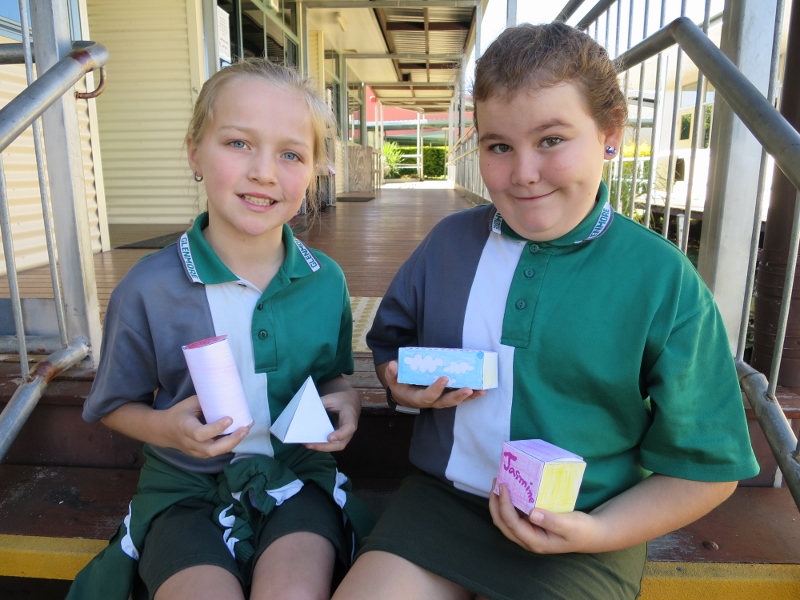
Jessica and Jasmine with their 3-D shapes
In Term One the Year five students will learn about habitats and adaptations in Science. As part of their assessment task the students need to create an animal that would be best suited to a beach or rainforest environment. The students need to explain why they selected the physical characteristics for their animal and predict how they would behave in the habitat.
Here are some of the animals the students created and some of the behaviours they believe their animal would exhibit:
This animal won’t look after their young because they need to learn how to catch insects on their own, therefore the mother will make their nest like crocodiles and alligators do (by burying them under ground). The mother will protect their young by surrounding the nest with leaves, and the mother will leave paralysed insects for the young to eat. They will hatch after 20 days or more.
This animal is a loner (never lives in groups) because if they are in groups they will fight to determine who is dominant, and they could die. Only animals that have lots of BIG predators live in groups, but in this environment there are only small mammals.
This animal hunts at night because it is a lot cooler at night and most insects are active. Insects such as mosquitoes and moths are active at night, perfect for hunting. The insects that sleep under rocks at night are easy to eat because they won’t fly or run away.
This animal is most active at night because it is 55 degrees during the day time and it is a lot cooler at night. It will look for shade during the day and sleep there. This animal lives in caves under cliffs where there is shallow water and lots of shade.
By Elijah
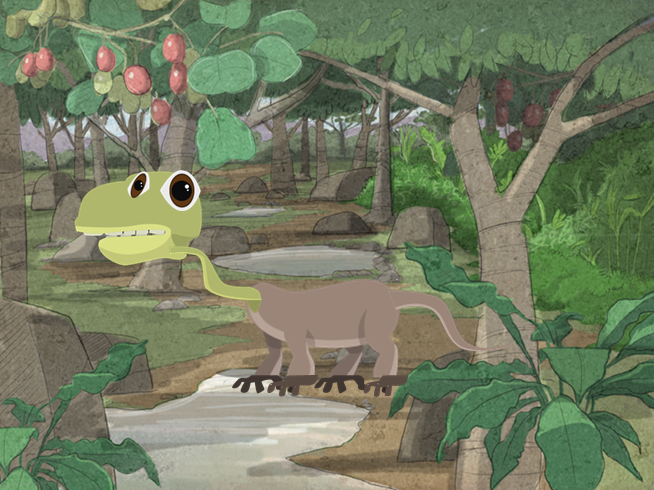
This animal breeds with a male and the young follows their parents for one to two years because the young cannot see until they are five months old.
This animal lives in a group because they could easily get lost in the forest. It is easy living with a family because the young lays on their mother’s back and the parents can climb trees for safety.
The mother stays to look after the young because the mother has milk to feed their babies. The male goes hunting because the males are stronger and can fight predators away from its meat. The animal is most active at night because the animal's eyes can see very well at night.
By Hau

My animal breeds only during summer and looks after the baby until they know how to hunt and protect themselves from predators. The young learn how to defend themselves by fighting their family and other small animals.
Before the baby leaves they first live in a herd to protect them when they get attacked by their predators.
The males are the ones that hunt while the females stay and take care of the young ones. The males hunt for fish, crabs and squids. When they catch the food they store it in their mouth and take it back to their herd so they can all feed on the food. The animals only eat 8 or 9 times a year.
This animal is mostly active during winter because during winter they do not sleep. Only the young ones sleep during winter because that is when predators attack the herd.
By Karl
 This animal lives by itself so when it goes hunting and gets something to eat it does not have to share its food with others. This animal will mate and then have its young. This animal will look after its young until it can go hunting for food and defend itself.
This animal lives by itself so when it goes hunting and gets something to eat it does not have to share its food with others. This animal will mate and then have its young. This animal will look after its young until it can go hunting for food and defend itself.
This animal will hunt in the day because in the day there is some sunlight so the animal can keep warm. Most of the animals are active in the day because they can keep warm. They can also see in the day because there are low levels of sunlight in rainforests.
By Victoria
________________________________________________________________________
Each year our Year Five students complete a novel study of an Australian classic - Storm Boy by Colin Thiele. The students begin by reading the novel as part of our CAFE reading program and analyse the characters, setting, plot and themes in the novel. After watching the movie the students apply their higher order thinking skills to make comparisons between the two versions.
The students are asked to write a statement reflecting on Storm Boy. Here are some of their prior examples:
Storm Boy was a very enjoyable film for a number of reasons, but I particularly enjoyed the characters. The characters were well-developed and their backstories were told really well. There was also a lot of detail shown through their facial expressions, actions, thoughts and the environment.
Storm Boy has brown and blackish hair. He is a strong boy who wears black shorts and a black coat. Hideaway Tom, Storm Boy's father, is kind and loyal to people. He doesn't shout, but remains calm. He did show emotions when Mr Percival was shot, particularly anger and sadness. Mr Percival is a clever pelican. At first he doesn't understand Storm Boy or Hideaway, so when a storm threatened men on a ship it took a while for Mr Percival to drop a long rope to the ship. If Mr Percival didn't get it correct the six men would have drowned.
Storm Boy is a slim and strong boy living in a small shack with his father, Hideaway Tom. Storm Boy had three pelicans, but they grew too big and had to leave. The best part of Storm Boy was when Mr Percival saved six men in a boat, but the saddest part was when Mr Percival died.
The reason why I really like this book is because it had an amazing pet, Mr Percival. I felt terribly sad when Storm Boy's pet died, but I liked it when Storm Boy was kind enough to help the poor pelicans. They were all really brave to save the six people on the ship in a storm. I felt sorry for Storm Boy because his mother died. He was a really happy boy for most of the book. All of the characters in Storm Boy were particularly good characters.
The book taught me that you should never kill a duck or any kind of bird. Mr Percival was smart for warning the ducks. He was quite friendly to all of the animals on the whole island. That is why I enjoyed the book. 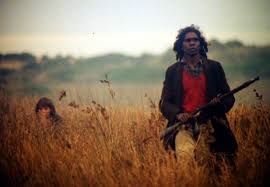
My favourite character in Storm Boy is Fingerbone because he makes the story more exciting. The best part of Storm Boy was when Fingerbone came into the story with a blunderbuss and shot a red-belly black snake to pieces.
I enjoyed Storm Boy because it was a good book to read and learn from. My favourite character is Storm Boy. He is an eleven year old boy who has short brown hair. Storm Boy loves to go fishing with his father, Hideaway Tom. He also likes to play on the beach with the three pelicans called Mr Proud, Mr Percival and Mr Ponder.
________________________________________________________________________
Our students will also learn about the history of the local area and combine their investigations with the Visual Arts. As part of this unit the students may carefully study the design of our local historical buildings and use perspective and shading to add depth to an image. Here are some of their bark huts:

By Cooper

By Daniel
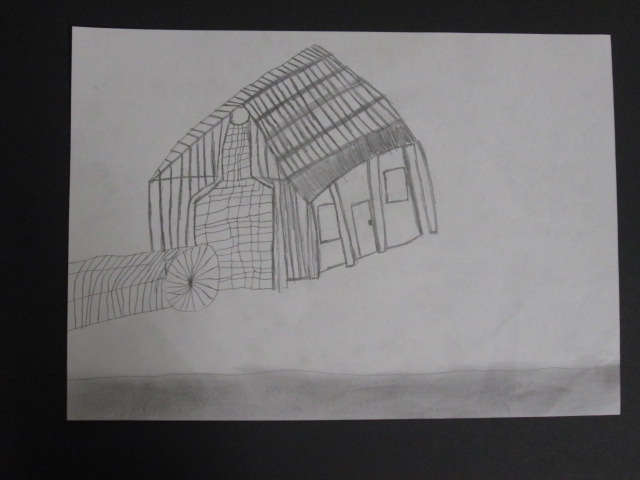
By Franz
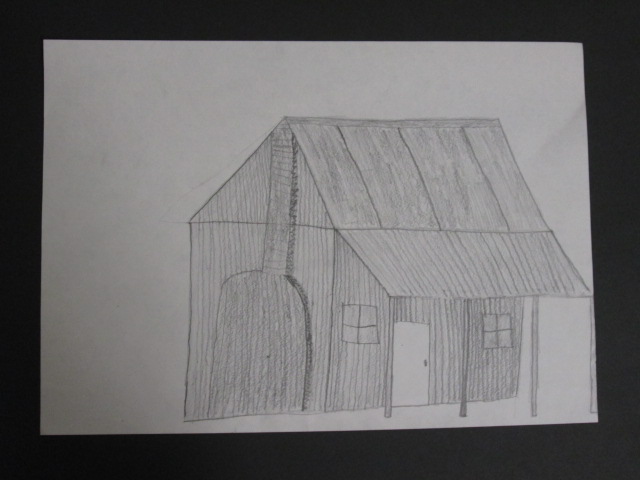
By Juliana

By Stephanie

By Chase